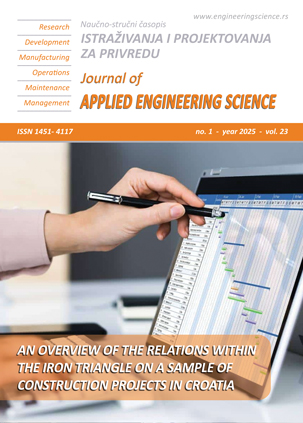SIMULATION OF AN ELECTRIC VEHICLE FIRE ON A RO-RO FERRY
Abstract
With the increasing demand for electric vehicles (EVs), the maritime transportation of these vehicles has become commonplace. Nevertheless, transporting EVs via car carriers presents a potential fire hazard. Data from the National Transportation Safety Board (NTSB) indicates that in 2020, 52 recorded fires involving EVs in the United States. These fires may be attributed to various factors, including battery malfunctions, overcharging, and damage sustained during transit. Once ignited, these fires can spread rapidly due to the proximity of the vehicles and the limited firefighting resources available on board. Numerous fire incidents involving car carriers transporting EVs have prompted safety concerns and underscored the necessity for enhanced regulations and safety protocols in recent years. According to the National Transportation Safety Committee (NTSC), Indonesia has reported 34 fires on vessels from vehicle incidents since 2007. Consequently, this research aims to mitigate damage and ascertain whether existing extinguishing systems effectively extinguish EV fires or if new recommendations are warranted. This study employs the Fire Dynamic Simulator (FDS) program to simulate fire behaviour, smoke propagation, and extinguishing. The findings highlight the importance of reducing fire temperatures to below 70°C within 400 to 500 s, particularly in the recommended scenario 2, which involves utilizing dedicated EV confined spaces. Ultimately, this approach minimizes smoke dispersal and emphasizes the necessity of lower temperatures for effective firefighting measures and reducing damage severity.
References
Aziz, M., Marcellino, Y., Rizki, I. A., Ikhwanuddin, S. A., & Simatupang, J. W. (2020). Studi Analisis Perkembangan Teknologi Dan Dukungan Pemerintah Indonesia Terkait Mobil Listrik. TESLA: Jurnal Teknik Elektro, 22(1), Article 1. https://doi.org/10.24912/tesla.v22i1.7898
IRENA. (2017). Renewable Energy Prospects: Indonesia, a REmap Analysis. International Renewable Energy Agency (IRENA). https://www.irena.org/remap
Pribadi, A. (2023, April 3). Kebut Program Kendaraan Listrik, Pemerintah Keluarkan Aturan Insentif PPN. ESDM. https://www.esdm.go.id/id/media-center/arsip-berita/kebut-program-kendaraan-listrik-pemerintah-keluarkan-aturan-insentif-ppn
Ini Komitmen Indonesia Mencapai Net Zero Emission. (2023, April 3). https://www.kemenkeu.go.id/informasi-publik/publikasi/berita-utama/Ini-Komitmen-Indonesia-Mencapai-Net-Zero-Emission
Yong, J. Y., Ramachandaramurthy, V. K., Tan, K. M., & Mithulananthan, N. (2015). A review of the state-of-the-art technologies of electric vehicles, their impacts and prospects. Renewable and Sustainable Energy Reviews, 49, 365–385. https://doi.org/10.1016/j.rser.2015.04.130
Sun, P., Bisschop, R., Niu, H., & Huang, X. (2020). A Review of Battery Fires in Electric Vehicles. Fire Technology, 1–50. https://doi.org/10.1007/s10694-019-00944-3
Ghiji, M., Novozhilov, V., Moinuddin, K., Joseph, P., Burch, I., Suendermann, B., & Gamble, G. (2020). A Review of Lithium-Ion Battery Fire Suppression. Energies, 13(19), Article 19. https://doi.org/10.3390/en13195117
Matteo, S. D. (2023). Fire Risk of Electric Vehicles in Confined Spaces [Masters Degree]. Politecnico di Torino.
Valasek, L. (2013). The use of PyroSim graphical user interface for FDS simulation of a cinema fire. International Journal of Mathematics and Computers in Simulation, 7(3), 258–266.
Gurning, C. (2016). Fire Risk Assessment For Safety Plan On Kmp Port Link 3 Through Fire Dynamic Simulator—unpublished report.
Lisbona, D., & Snee, T. (2011). A review of hazards associated with primary lithium and lithium-ion batteries. Process Safety and Environmental Protection, 89(6), 434–442. https://doi.org/10.1016/j.psep.2011.06.022
Qi, W., Shapiro, J. G., Wu, Q., Yin, T., Gao, G., & Cui, D. (2017). Nanostructured anode materials for lithium-ion batteries: Principle, recent progress and future perspectives. Journal of Materials Chemistry A, 5(37), 19521–19540. https://doi.org/10.1039/C7TA05283A
Un, C., & Aydın, K. (2021). Thermal Runaway and Fire Suppression Applications for Different Types of Lithium Ion Batteries. Vehicles, 3(3), Article 3. https://doi.org/10.3390/vehicles3030029
Feng, X., Ouyang, M., Liu, X., Lu, L., Xia, Y., & He, X. (2018). Thermal runaway mechanism of lithium-ion battery for electric vehicles: A review. Energy Storage Materials, 10, 246–267. https://doi.org/10.1016/j.ensm.2017.05.013
Ribière, P., Grugeon, S., Morcrette, M., Boyanov, S., Laruelle, S., & Marlair, G. (2012). Investigation on the fire-induced hazards of Li-ion battery cells by fire calorimetry. Energy & Environmental Science, 5(1), 5271–5280. https://doi.org/10.1039/C1EE02218K
Hynynen, J., Willstrand, O., Blomqvist, P., & Andersson, P. (2023). Analysis of combustion gases from large-scale electric vehicle fire tests. Fire Safety Journal, 139, 103829. https://doi.org/10.1016/j.firesaf.2023.103829
Babrauskas, V., & Peacock, R. (1992). Heat Release Rate: The Single Most Important Variable in Fire Hazard. Fire Safety Journal, 18, 255–272. https://doi.org/10.1016/0379-7112(92)90019-9
Kim, H.-J., & Lilley, D. G. (2000). Heat Release Rates of Burning Items in Fires. American Institute of Aeronautics and Astronautics, 2000–0722.
Hill, D. (2017). Considerations for Energy Storage Systems (ESS) Fire Safety (p. 97). DET NORSKE VERITAS (U.S.A.), INC. (DNV GL).
Kong, L., Li, C., Jiang, J., & Pecht, M. (2018). Li-Ion Battery Fire Hazards and Safety Strategies. Energies, 11, 2191. https://doi.org/10.3390/en11092191
Larsson, C. F. (2017). Lithium-ion Battery Safety—Assessment by Abuse Testing, Fluoride Gas Emissions and Fire Propagation [Chalmers University of Technology]. https://research.chalmers.se/en/publication/251352
Long, R. T., Blum, A. F., Bress, T. J., & Cotts, B. R. T. (2013). Best Practices for Emergency Response to Incidents Involving Electric Vehicles Battery Hazards: A Report on Full-Scale Testing Results. National Fire Protection Research Foundation.
Mikolajczak, C., Kahn, M., White, K., & Long, R. T. (2011). Lithium-Ion Batteries Hazard and Use Assessment. Springer US. https://doi.org/10.1007/978-1-4614-3486-3
Yuan, S., Chang, C., Zhou, Y., Zhang, R., Zhang, J., Liu, Y., & Qian, X. (2022). The extinguishment mechanisms of a micelle encapsulator F-500 on lithium-ion battery fires. Journal of Energy Storage, 55, 105186. https://doi.org/10.1016/j.est.2022.105186
Ha, G., Shin, W. G., & Lee, J. (2021). Numerical analysis to determine fire suppression time for multiple water mist nozzles in a large fire test compartment. Nuclear Engineering and Technology, 53(4), 1157–1166. https://doi.org/10.1016/j.net.2020.09.028
Khoat, H., Kim, J., Quoc, T., Kwark, J., & Ryou, H. (2020). A Numerical Analysis of the Fire Characteristics after Sprinkler Activation in the Compartment Fire. Energies, 13, 3099. https://doi.org/10.3390/en13123099
Kang, S., Kwon, M., Yoon Choi, J., & Choi, S. (2023). Full-scale fire testing of battery electric vehicles. Applied Energy, 332. https://doi.org/10.1016/j.apenergy.2022.1204

